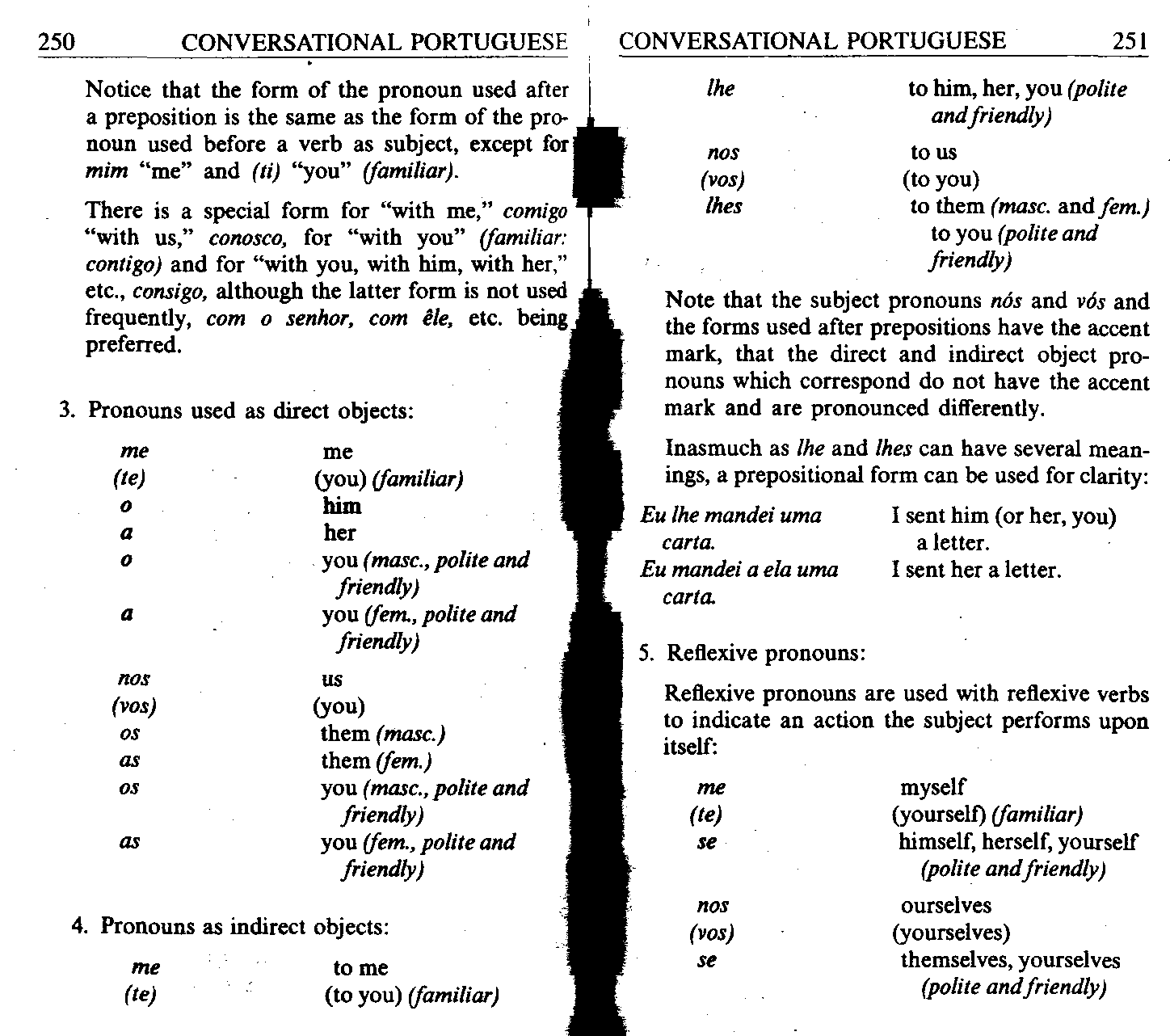Summary p250

250 CONYERSATIONAL PORTUGUESE CONYERSATIONAL PORTUGUESE_ 251
(te)
II
|
Ihe |
to him, her, you (polite |
|
andfriendly) | |
|
nos |
to us |
|
(vos) |
(to you) |
|
Ihes |
to them (masc. and fem.) |
to you (polite and friendly)
Notice that the form of the pronoun used after a preposition is the same as the form of the pronoun used before a verb as subject, except for mim “me” and (ti) “you” (famitiar).
There is a special form for “with me,” comigo “with us,” conosco, for “with you” (familiar: contigo) and for “with you, with him, with her,” etc., consigo, although the latter form is not used freąuently, com o senhor, com ile, etc. being preferred.
3. Pronouns used as direct objects:
|
me |
me |
|
(te) |
(you) (familiar) |
|
0 |
him |
|
a |
her |
|
o |
you (masc., polite and |
|
friendly) | |
|
a |
you (fenu, polite and |
|
friendly) | |
|
nos |
us |
|
(vos) |
(you) |
|
os |
them (masc.) |
|
as |
them (Jem.) |
|
os |
you (masc., polite and |
|
friendly) | |
|
as |
you (fempolite and |
friendty)
4. Pronouns as indirect objects: me to me
(to you) (familiar)
Notę that the subject pronouns nós and vós and the forms used after prepositions have the accent mark, that the direct and indirect object pronouns which correspond do not have the accent mark and are pronounced difTerently.
Inasmuch as Ihe and Ihes can have several mean-ings, a prepositional form can be used for clarity:
Eu Ihe mandei urna I sent him (or her, you) carta. a letter.
Eu mandei a ela urna I sent her a letter. carta.
5. Reflexive pronouns:
Reflexive pronouns are used with reflexive verbs to indicate an action the subject performs upon itself:
|
me |
myself |
|
(te) |
(yourself) (familiar) |
|
se |
himself, herself, yourself |
|
(polite andfriendly) | |
|
nos |
ourselves |
|
(vos) |
(yourselves) |
|
se |
themselves, yourselves |
(polite andfriendly)
Wyszukiwarka
Podobne podstrony:
Summary p222 222 CONYERSATIONAL PORTUGUESE 21. Vamos_(to have dinner). a. jantar
Summary p224 224 CONYERSATIONAL PORTUGUESE (3) variations occur in different areas: a.
Summary p226 226 CONYERSATIONAL PORTUGUESH CONYERSATIONAL PORTUGUESE 227 d g g h j I I Ut m as d i
Summary p230 230 CONYERSATIONAL PORTUGUESE 3, The cedilla (cedilha) is used with
Summary p234 234 CONYERSATIONAL PORTUGUESE k. with parts of the body and articles of clothing inst
Summary p236 236 CONYERSATIONAL PORTUGUESE De and em combine with the demonstrative forms (see GS2
Summary p238 238 CONYERSATIONAL PORTUGUESE 13. MASCULINE AND FEMININE 238 CONYERSATIONAL PORTUGUES
Summary p240 240 CONYERSATIONAL PORTUGUESE 14. THE PLURAL 1. Nouns ending in a vowel, including na
Summary p242 242 CONYERSATIONAL PORTUGUESE seu can also be used to translate “his,” “her,” “their.
Summary p246 246 CONYERSATIONAL PORTUGUESE 1«. COMPAR1SON 1. Rcgular comparison facil easy ma
Summary p248 248 CONYERSATIONAL PORTUGUESE 19. PRONOUNS Pronouns have varying forms depending on w
Summary p254 254 CONYERSATIONAL PORTUGUESE Nao me escreva mais. Eles decidiram que nos mandar
Summary p256 256 CONYERSATIONAL PORTUGUESE 21. SOME CONJUNCTIONS ainda que assim que ate
Summary p258 258 CONYERSATIONAL PORTUGUESE 23. ADYERBS 1. Some Portuguese adverbs are formed by ad
Summary p260 260 CONYERSATIONAL PORTUGUESE la (acold) there (morę remote) adiante . forward,
Summary p262 262 CONYERSATIONAL PORTUGUESE sabdo soap sabonete a cake of toilet
Summary p264 264 CONYERSATIONAL PORTUGUESE Ndo ąuero este sem I don’t want this one
Summary p266 266 CONYERSATIONAL PORTUGUESE27. NEGATION 1. Ndo “not” comes before
Summary p268 268 CONYERSATIONAL PORTUGUESE 2. The personal infinitiye has endings which make it ea
więcej podobnych podstron